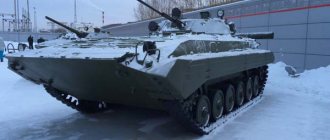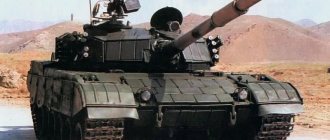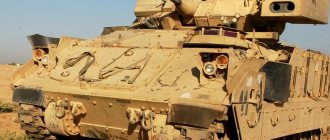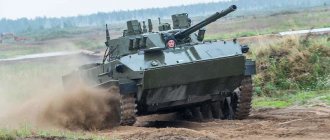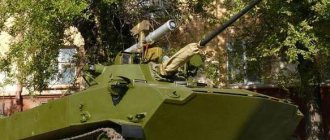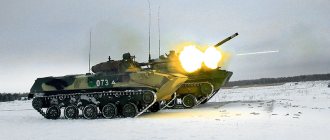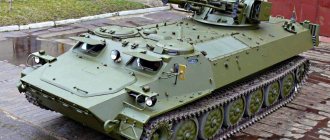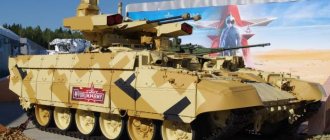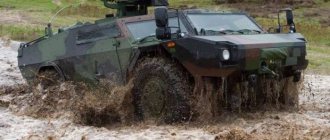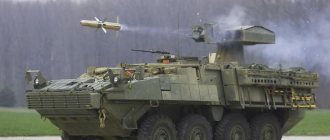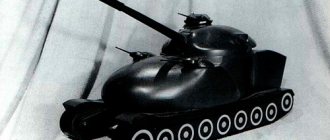Details Category: Tanks and Armored Vehicles Published: 05/19/2017
BMP K-17 Boomerang is the newest Russian wheeled infantry fighting vehicle. This type of armored personnel carrier meets the general trend - the universalization of the Russian army by 2020, and is guaranteed to enter service in 2019. The appearance has nothing in common with Russian and Soviet-made armored personnel carriers; a 25-ton landing vehicle with an 8x8 wheel arrangement can become lighter or heavier, turn into an armored personnel carrier, infantry fighting vehicle or tank
- History of creation
- Specifications
- Armor and protection systems
- Armament.
Modifications
BMP-2M Berezhok
BMP-2M "Berezhok" is a Russian modification of the BMP-2. An additional panoramic sight is installed. The location of the AGS-17 has been changed, 4 Kornet ATGM launchers have been installed. In 2005, a contract was signed with Algeria to modify 300 vehicles to the BMP-2M level.
BMP-2D
Developed in 1981 specifically for combat in Afghanistan. During the Afghan war, developers and the military suddenly learned that opponents were shooting not only in the forehead, but also at the side and rear of the infantry fighting vehicle, which was not expected in a combined arms battle (according to the experience of the Second World War), and the security of the sides was sacrificed in favor of the ability to overcome water obstacles on your own. The epiphany was costly, but as a result of the epiphany, the BMP-2D appeared during the fighting.
This is an infantry fighting vehicle - BMP-2D. This is the only modernization of the BMP-2 in 32 years of service. Many people who fought in Afghanistan remember this car with kind words. In fact, the BMP-2D is the vehicle that is needed to wage war. Yes, this vehicle lost the ability to swim, but the armor appeared (even if it was light and bulletproof) not only in the frontal projection and became circular. Unfortunately, the “armor” of the BMP-1/2, in its pure form, cannot boast of all-round bulletproof protection.
These photographs, for clarity, show the location of additional armor on the main body of the infantry fighting vehicle. Additional armor is not simply hung, but at some distance from the main armor of the hull. This distance is around 50 - 60 mm. This was done to improve bulletproof and anti-cumulative protection. In essence, this is classic shielding which led to an increase in the weight of the infantry fighting vehicle, but within reason. In the case of the BMP-2D, the weight of the vehicle has changed from the ceremonial model by 500 kg.
BMP-2 weighs 14,000 kg, and BMP-2D weighs 14,500+2% kg. As can already be seen from the very first photo, the sides of the vehicle have undergone increased armor protection.
And one of the weak points identified during combat operations in Afghanistan by Soviet troops in the BMP-1 and BMP-2 vehicles was the rear part of the turret, which was penetrated by small arms fire. On the BMP-2D this drawback was eliminated.
In addition, another weak point of the base BMP-1 and the BMP-2, which migrated from it to the BMP-2, was additionally strengthened - this is the bottom in the area of the driver and the gunner located behind him. On all BMP-2D vehicles, the bottom was additionally reinforced in this area.
PS 10 years after the withdrawal of troops from Afghanistan, not a single BMP-2D vehicle remained in the Russian army. One single copy stands in the armored tank museum in Kubinka.
BMP-2 with the Bakhcha-U combat module
Experimental modification of the BMP-2 with the Bakhcha-U combat module. Developed in 1999-2000. The modernization was done with the aim of increasing the combat power of the BMP-2 to the level of the BMP-3. However, due to the large volume of transported equipment, the landing party was reduced to 5 people, and due to the increased mass, the ability to swim was lost. In fact, the vehicle turned into a non-floating armored personnel carrier.
BMP-2 with Rostock combat module
BMP-2 with AGS-17 "Flame"
The BMP-2 modification differs from the base vehicle in the presence of the AG-17 “Plamya” grenade launcher. The grenade launcher is mounted at the rear of the turret. Guidance is carried out remotely by the operator-gunner or commander. The ammunition is in a box with a tape for 250 shots. Produced in a small series.
BMP-2K
Created to control motorized rifle units. The car has an additional short-wave radio station; for long-distance communication, a mast antenna is installed. Other characteristics are similar to the base car.
Foreign modifications
BVP-2 - BMP-2, produced under license in 1984-1987 in Czechoslovakia in Detva and ZTS in Dubnica nad Vahom. 344 copies were produced.
"Sarath" - BMP-2, produced under license in India
BMP-2 - modification of the BMP-2 for the Finnish Army
History of creation
The vehicle was created as a result of modification of the BMP-1. Work in this direction has been carried out at the design bureau of the Kurgan Machine-Building Plant since 1974 under the GBTU indices “Object 675” and “Object 680”. Also, the issue of modernizing the BMP-1 has been studied at the Chelyabinsk Tractor Plant since 1972 under the symbol “Object 769”. In 1980, a version of the Kurgan Machine-Building Plant was adopted, where mass production of the BMP-2 was launched.
Description of design
The crew of the vehicle consists of three people - a driver, an operator-gunner and a commander. The vehicle also carries a landing force of 7 people, who can fire through special embrasures from personal weapons.
Armored hull and turret
The hull and turret of the BMP-2 are welded from rolled steel armor plates with a thickness of 5 to 19 mm. The turret forehead is 23 mm thick.
In the left front part of the car there is a control compartment, in which there is a place for the driver with controls for the movement of the car, surveillance devices and a communications device. Behind the driver is the gunner's seat, equipped with an embrasure for firing personal weapons, as well as surveillance devices and communications equipment.
The engine and transmission compartment is located in the right front part of the machine, along the length of the machine it is combined with the control compartment and separated from it by a heat and sound insulating partition. For access to MTO units, there are hatches in the partition.
In the middle part of the vehicle there is a fighting compartment, which occupies the turret and the turret space of the hull. The fighting compartment contains the workstations of the operator-gunner and commander, as well as the main and auxiliary weapons. In the turret space there is a rotating floor in which boxes with machine gun cartridges are mounted, as well as a belt feeding system for the gun with armor-piercing tracer and fragmentation rounds. On the right side of the hull there are three stacks with ATGM rounds, another is located in the turret space.
In the troop compartment, located at the rear of the vehicle, there are 6 places for shooters. Each has an embrasure for firing from personal weapons. In the stern there are two doors for the landing. The left door has an embrasure for firing from a machine gun. Also, for dismounting troops when moving afloat or emergency evacuation, there are two hatches above the seats in the hull roof. The troop compartment is separated by a middle fuel tank and an electrical equipment container that contains batteries, a heater and other electrical units.
Armament
The main difference between the BMP-2 and the BMP-1 is the new weapon system. The reason for the replacement was the experience of using the BMP-1 weapons, which had difficulty coping with the task of hitting typical infantry targets, especially those with lying down or hidden enemy personnel. The fight against low-flying air targets and light armored personnel carriers was problematic, and due to the low power of ammunition, low accuracy and short range of the 2A28 gun, the fight against tank targets was not effective.
The main armament of the BMP-2 is a 30-mm 2A42 automatic cannon with 500 rounds of ammunition. Coaxed with the cannon is a 7.62 PKT machine gun, which has 2,000 rounds of ammunition. In addition, to combat tanks, the BMP-2 has a 9K111 “Fagot” or 9K111-1 “Konkurs” ATGM with 4 rounds.
The vehicle was also equipped with 6 grenade launchers of the 902B “Tucha” smoke screen system for firing 81-mm smoke grenades.
Surveillance and communications equipment
The driver's seat is equipped with surveillance devices and an A-3 tank intercom. The shooter's position behind him is equipped with TNP-165A and TNPO-170A surveillance devices. For communication there is an A-3 TPU device.
At night, the driver uses the TVN-2 device, which is installed immediately before leaving instead of the front triplex. The range and viewing angles of the TVN-2 are not large (in complete darkness), therefore, the driver cannot see what is on the sides of the vehicle; this is already the responsibility of the commander and gunner operator with a report via intercom. The equipment is included with the equipment, but is most often stored separately from the machine.
The commander and operator's workstations have observation and aiming devices. The commander's station is equipped with an R-123M radio station and an A-1 TPU apparatus. The operator has an A-2 TPU device for internal communication.
The gunners' workplaces in the troop compartment and the aft doors for dismounting are equipped with TNPO-170A devices for monitoring the terrain. For internal communications, the troop compartment uses A-3 and A-4 TPU devices. In the right door there is a radio station R-126.
For aiming, the gunner operator uses a combined sight (depending on the modification, either BPK-1-42 or BPK-2-42) with a 5.6-fold magnification during the day and 5-fold at night. To operate in active mode, an OU-5 illuminator is installed on the machine. In addition to the sight, the gunner has 3 periscope devices TNPO-170A with electrical heating, as well as 1 rear observation device TNPT-1. For the vehicle commander, two TNPO-170A and one TNPT-1 devices, a TKN-3B binocular viewing device and a 1PZ-3 day sight are installed for searching for air and ground targets and aiming weapons at them.
Engine and transmission
The engine and transmission compartment of the car is divided into two blocks. The first block is the power unit and combines the engine, planetary rotation mechanisms and gearbox. The second is a cooling and cleaning unit, which combines radiators for the cooling system, engine lubrication, ejector, air cleaner and transmission oil system.
The engine is a 6-cylinder 4-stroke uncompressor diesel UTD-20S1 liquid-cooled with direct injection. The maximum power is 210-221 kW. The total mass of the dry engine is about 700 kg.
The power unit is located at the very front of the vehicle, under the “ribbed” upper armor plate. It includes a transmission including gearbox, steering components, and clutch. All this, to one degree or another, can be repaired in the field, since there is direct access. The engine, located to the right of the driver, is completely closed and without special equipment, access to it is almost impossible. The only way to the engine is blocked by an armored plate above it, and without serious lifting equipment it is not worth even trying to make repairs. However, the designers clearly thought through this situation: if something happens to the engine, then the vehicle is not combat-ready and, therefore, requires major repairs, and this can only be properly carried out in a specialized place.
Engine repairs are not possible through the hatches in the internal partition; only routine maintenance is carried out through them. In addition, they are used in the cold season, when the engine has already warmed up, and the temperature in the cabin is not yet higher than outside, although the command “get to the cars!” has already arrived. This is where they save the day: the driver and the gunner sitting behind him receive the first portion of heat, then those sitting in the turret, and only then the troop compartment, with the condition that they travel for a long time and the rear doors do not open often. It should be noted that in general this compartment does not have much time to warm up, since the hatches close when a comfortable temperature for the driver is reached. After this, heating occurs due to partitions and forced heated air into the cabin.
Chassis
The base is a chassis with a six-wheel chassis; the design and characteristics are similar to the BMP-1. On rough terrain or a dirt road (if not similar to an asphalt road), the speed of movement is no more than 40-45 km/h.
The BMP series vehicles use a unique steering control, something between the steering wheel in an armored personnel carrier and the levers in tanks, this is the so-called “steering wheel”, consisting of only two horizontal handles. With the same freedom of rotation as the steering wheel, this allows you to control the car like a wheeled vehicle, with the only difference being that its angle of deflection has its own limitations. When you turn it to the side, there is a smooth, uniform redistribution of thrust on the tracks, this is what allows you to avoid jerking the car when turning, as usually happens with tracked vehicles, which ultimately has a detrimental effect on the rollers and tracks. After releasing it, the “steering wheel” itself returns to its original state. Consequently, force must be applied only when turning, and the horizontal position at this moment indicates that the car is moving in a straight line. Thanks to this design, the control of the machine is greatly facilitated and maneuvers such as a snake at speed are smoother.
Where did the idea for K-17 come from? A new class of infantry fighting vehicles based on the Boomerang - background
Representatives of the country's military-industrial complex want to please everyone - the Russian army and the armies of foreign countries that adhere to NATO standards. At first, the project was a joint one with the French Renault, then the United States imposed sanctions against the Russian Federation - as a result: the K-17 BMP became only Russian, on which 40 Russian enterprises worked. The project retained the unusual NATO dimensions in height and length of the body, as well as heavy armor.
A simplified modification can be sold, which will save the 2022 rearmament program, and, therefore, will not stop the strengthening of the state’s defense capability due to some lack of money. Now we have to borrow from the same NATO, which since 2003 has been supplying the US Army with Strikes similar to the Boomerang, followed by the Germans. The Italians, French and other countries of the alliance are arming themselves with their own or allied similar equipment. We have to catch up in quantity and surpass in quality. The difference between the Russian Federation and NATO in class will grow.
In an interview with journalists, the director of VPK LLC, Dmitry Galkin, said that the Boomerang is not an armored personnel carrier, but a medium platform on wheels for armored personnel carriers, infantry fighting vehicles and tanks. He noted that this is not about modernizing the BTR-90 prototypes, but about creating a completely new combat unit. Logistics and technical support transport will also be installed on this platform in the near future. The project from VPK LLC VPK-7829, now known as the K-17 BMP, will be produced at the Arzamas Machine Plant. The military first became aware of it in 2013 at the closed exhibition RussiaArmsEXPO, and the public saw the K-17 Boomerang BMP at the Victory Parade on 05/09/2015.
Read BMD 4 - a new generation airborne combat vehicle
The Russian military wants to see the Boomerang floating, which means that a technical limitation is established in the hull armor and in the choice of weapons, because then the mass of the vehicle cannot be exceeded - 25 tons. This became the cause of disputes with the Minister of Defense of the Russian Federation, as well as the desire of our officers to install loopholes, which also reduces the protection of the crew and paratroopers with armor. Therefore, the armor is made removable, divided into light, medium and heavy; quality has been improved due to multi-layering and the use of ceramics.
Performance characteristics of the BMP-2
Crew, persons: 3 Troops, persons: 7 Layout: engine compartment in front, combat compartment in the center, landing compartment in the rear
Weight of BMP-2
— 14.0 tons
Dimensions of BMP-2
— Case length, mm: 6735 — Case width, mm: 3150 — Height, mm: 2450 (according to the illuminator); 2250 (according to aiming devices) - Base, mm: 3600 - Track, mm: 2550 - Ground clearance, mm: 420
BMP-2 armor
— Armor type: rolled homogeneous steel (bulletproof, anti-fragmentation)
Armament of the BMP-2
— Caliber and brand of gun: 30 mm 2A42 — Type of gun: rifled small-caliber automatic gun — Gun ammunition: 500 (armor-piercing, high-explosive fragmentation) — Firing range, km: up to 4 on ground; up to 2.5 by air - Sights: BPK-2-42 (BPK-1-42) - binocular day and active-passive night and anti-aircraft 1PZ-3 - Machine guns: 1 × 7.62 mm PKT - Other weapons: ATGM 9K111 or 9K113
BMP-2 engine
— Engine type: UTD-20S1 — Engine power, l. s: 300
Speed of BMP-2
— Speed on the highway, km/h: 65 — Speed on rough terrain, km/h: 40–50 on dirt road; 7 afloat — Cruising range on the highway, km: 550—600 — Specific power, l. s./t: 20.3—21.74 — Specific ground pressure, kg/cm²: 0.64—0.66 — Elevation to be overcome, degrees: 35° — Wall to be overcome, m: 0.7 — Ditch to be overcome, m: 2.5 - Fordable, m: floating.
Design features of the new T-15 infantry fighting vehicle
The armored vehicle was created entirely on the tracked base of the T-14 Armata tank. The weight of the new combat vehicle is 48 tons, which is even more than the weight of the main Russian T-90 tank. For comparison, the weight of the BMP-1 and BMP-2 was only 12 and 14 tons, respectively. The American M2 Bradley infantry fighting vehicle weighed almost half as much, about 22-27 tons, depending on the modification of the vehicle. A review of the power plant allows us to say that, despite such an impressive weight, the Russian infantry fighting vehicle is capable of reaching speeds of up to 70 km/h. The engine power and ground clearance provide the vehicle with high maneuverability for vehicles in its class.
The vehicle's maneuverability and movement are ensured by an engine located in the bow of a durable armored hull. The rear part of the hull is equipped for transporting an infantry unit. It is assumed that the passenger compartment will be able to freely accommodate 7-9 fighters with full combat gear.
The turret of the combat vehicle deserves special attention. This is no longer the usual turret with space for the loader and commander, but an automated combat module “Epoch”. The entire complex of equipment and weapons installed in the module is controlled remotely. The new module is a further development of the Boomerang combat module, which was equipped with the Kurganets 25 infantry fighting vehicle and the new generation armored personnel carrier. This decision was the result of the implementation of the requirement of the military leadership to make all combat modules unified. Combat modules are installed on all new armored vehicles entering the military.
The Epoch combat module is an artillery platform for a 30 mm automatic cannon. A Kalashnikov PKT tank machine gun is installed next to the 2A42 cannon. In addition to machine gun and artillery weapons, the module is equipped with 4 Kornet-EM ATGM launchers. If an artillery gun and a machine gun are considered anti-personnel weapons, then anti-tank systems make the new combat vehicle an effective anti-tank weapon. During lengthy field tests, it was decided to install modules equipped with Ataka ATGMs and carrying a 57 mm automatic cannon on new infantry fighting vehicles. The new weapon will be capable of successfully hitting lightly armored vehicles, including those in service with Western armies.
The newest infantry fighting vehicle has composite armor, located in a different layout than the T-14 tank. The main job of protecting the vehicle is performed by the installed Afghanit active protection system, thanks to which the armored body of the vehicle is protected from enemy shells and missiles. The automated system not only detects enemy anti-tank missiles as they approach the vehicle, but also shoots them down. Provided that enemy missiles have overcome the protective line of active protection, the Malachite double-layer armor system comes into play. Both systems provide the T-15 BMP with a reliable line of defense before the main armored hull takes the attack.
Studying the history of military operations in Syria, reviewing the losses of the government army from rebel fire, it can be argued that the new infantry fighting vehicle appeared on time. A powerful, well-armored vehicle, armed with diverse types of weapons, is capable of successfully operating in new combat conditions. The vehicle is capable of quickly delivering infantry units to a specific location and creating sufficiently dense and intense fire support in this area.
For urban conditions, the T-15 BMP seems to be an ideal vehicle. This steel monster will feel no worse in field conditions. Possessing tank armor, good speed and powerful weapons, the new vehicle can not only quickly and successfully suppress enemy firing points, but also break through a fortified defense line.
It should be noted that not only potential opponents are interested in the new Russian development. The Russian T-15 infantry fighting vehicle was liked by the Indian military. The armies of Iraq, Kuwait, Thailand and Pakistan are thinking about purchasing the latest infantry fighting vehicles. By finalizing the project in accordance with export conditions, Russia can successfully compete in this segment with the Americans, who continue to supply their M2 Bradley infantry fighting vehicles to dozens of other armies. The cost of the vehicle is several times less than the cost of a battle tank. In terms of firepower and other technical parameters, this type of armored vehicle can freely solve problems typical of tank units.

